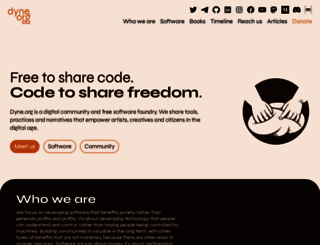Digital Community and Free Software Foundry
Page Load Speed
2.3 sec in total
First Response
117 ms
Resources Loaded
1.1 sec
Page Rendered
1.1 sec

About Website
Visit dyne.org now to see the best up-to-date Dyne content for India and also check out these interesting facts you probably never knew about dyne.org
🚀 Empowering artists, creatives and citizens for more than 20 years.
Visit dyne.orgKey Findings
We analyzed Dyne.org page load time and found that the first response time was 117 ms and then it took 2.2 sec to load all DOM resources and completely render a web page. This is quite a good result, as only 45% of websites can load faster.